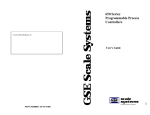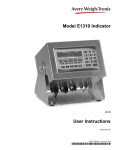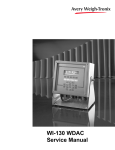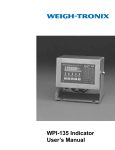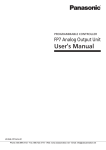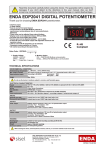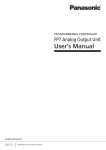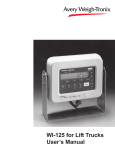Download PC-220 Counting Scale User`s Manual - Avery Weigh
Transcript
PC-220 Counting Scale User’s Manual EUROPEAN COUNTRIES WARNING This is a Class A product. In a domestic environment this product may cause radio interference in which the user may be required to take adequate measures. CAUTION Risk of electrical shock. Do not remove cover. No user serviceable parts inside. Refer servicing to qualified service personnel. Weigh-Tronix reserves the right to change specifications at any time. 12/13/04 PC220_U.P65 PN 29772-0013D e1 Printed in USA 2 PC-220 Counting Scale User’s Manual Table of Contents Introduction .................................................................................................................................... 5 Installation ............................................................................................................................... 5 Sleep Mode ............................................................................................................................. 5 Error Messages ...................................................................................................................... 5 PC-220 Front Panel ................................................................................................................ 6 Keypad ............................................................................................................................. 6 Display .............................................................................................................................. 6 Using the Scale ............................................................................................................................. 8 Zeroing the Scale .................................................................................................................... 8 Using the Clear Key ................................................................................................................ 8 Clearing a Numeric Entry ........................................................................................................ 8 Using Tares ............................................................................................................................ 8 Keying in a known tare weight .......................................................................................... 8 Cancelling a tare ............................................................................................................... 9 Sampling Parts for Counting ................................................................................................... 9 Normal sampling .............................................................................................................. 9 Reverse sampling ........................................................................................................... 10 Resampling ........................................................................................................................... 10 Manual resampling ......................................................................................................... 10 Using Piece Weights ............................................................................................................. 10 Keyboard Entry of Piece Weights ................................................................................... 10 Viewing Active Piece Weight .......................................................................................... 10 Clearing the Active Piece Weight ................................................................................... 10 Using the High Limit Alarm ................................................................................................... 11 Setting the high limit ....................................................................................................... 11 View the current high limit .............................................................................................. 11 Clearing the high limit ..................................................................................................... 11 Using Part Look Up (PLU) Keys ............................................................................................ 11 Creating a PLU ............................................................................................................... 11 Recalling a PLU Using the PLU key ...................................................................................... 12 Recalling a PLU Using a PLUX hot key ................................................................................. 12 Clearing a PLU ...................................................................................................................... 12 Clearing a PLU Using a PLUX hot key ................................................................................... 12 Accumulator Function ........................................................................................................... 13 Accumulating counts ...................................................................................................... 13 Viewing accumulator values ........................................................................................... 13 Clearing accumulator values .......................................................................................... 13 Management Mode ..................................................................................................................... 14 Beeper Alarm ........................................................................................................................ 15 Keyboard Beeper .................................................................................................................. 15 Weight Limit Beeper ............................................................................................................. 15 Error Beeper ......................................................................................................................... 15 Changing Beeper Volume ..................................................................................................... 15 Changing Backlight Time ...................................................................................................... 15 Changing Sleep Time ........................................................................................................... 16 Changing Duration of a Long Press ...................................................................................... 16 Changing Minimum Sample Weight ...................................................................................... 16 Changing Manual Resampling Range .................................................................................. 16 Changing Automatic Resampling Range .............................................................................. 16 Changing a PLU Item Weight ............................................................................................... 17 Changing a PLU Tare ........................................................................................................... 17 Protecting a PLU ................................................................................................................... 17 PC-220 Counting Scale User’s Manual 3 4 PC-220 Counting Scale User’s Manual Introduction This manual covers the operation of the PC-220 parts counting scale by Weigh-Tronix. Major sections of the manual begin with black barred text as seen above. Minor section headings appear in the left column along with important notes and warnings. Installation Place the unit on a firm, level surface that is free from drafts and vibration. Place the unit in a location ergonomically suited for the user. Level the scale using the adjustable footpads. Center the bubble in the bubble level located below the Weigh-Tronix logo on the front panel. The unit must be plugged into a properly grounded outlet that is within easy access from the scale location. Sleep Mode Short key press = 1 beep Long key press = 2 beeps Error Messages Plug the power adapter to an appropriate power source. See note at left. The display will perform a self-test and then show the normal display mode. To put the unit to sleep, long press the I/O key. See note on short vs. long key presses at left. To wake up the scale, short press the I/O key. Below are examples of various error messages you may see. If a persistent error message appears, disconnect then reconnect power to the unit. If problem persists, contact your local authorized Weigh-Tronix distributor. Temporary error Weight unsteady Over range Balance failed Under range Error Code: E0 Disconnect then reconnect power to the scale. E5 Disconnect then reconnect power to the scale. E 10 Battery failure. Recharge or replace batteries. E11 Power supply voltage is too high. E15 Contact local W-T distributor. E 20 Weight error. Remove weight from scale and long press the Clear key. E 30 Contact local W-T distributor. E 35 Contact local W-T distributor. E 100 Invalid PLU contents. Reprogram the PLU. E 101 Transaction failed. Remove weight from scale and long press the Clear key. E 102 PLU write failed. E 103 Tare failed. Remove weight from scale and long press the Clear key. PC-220 Counting Scale User’s Manual 5 PC-220 Front Panel Keypad The front panel of the PC-220 is made up of the keypad, for entering information, and the display. The keypad of the PC-220 is shown in Figure 1. The display window is shown in Figure 2. Figure 1 PC-220 front panel Below is a brief description of the keys on the keypad. Display On/Off key. Use this key to put the unit in sleep mode, wake it from sleep mode or to access menus. Use this key to zero the display. Use this key to clear all active PLUs, tares, piece weights and accumulator totals. Also used to clear an error message. Press this key to tare a weight from the scale. Use this key to calculate sample weights of items placed on the scale. Press this key to temporarily display the current pieceweight. Use this key to set high limit alarm. This beeping alarm sounds when the count exceeds the number you set. 6 PC-220 Counting Scale User’s Manual Use this key to accumulate counts of items and to view accumulated totals. Use this key to enter or recall a PLU for PLU memory slot 1-7. The three keys with arrows are also used when you navigate the menus in management mode and for service functions. Use this key to enter or recall a PLU for PLU memory slots 135. Use these keys to enter numbers for tares, piece weights, etc. Figure 2 PC-220 display window The appropriate annunciator will light next to the labels surrounding the display. For example, when in net weighing mode a small triangle will appear pointing at the word Net. When you are in the counting mode the screen will display the information shown in Figure 3. Figure 3 Count mode display information PC-220 Counting Scale User’s Manual 7 Using the Scale This section shows you the steps required to perform weighing and counting operations. The first few sections are general information on zeroing the scale, clearing values, and using tares. After that are specific instructions on performing sampling and doing counting operations. Zeroing the Scale Short key press = 1 beep Long key press = 2 beeps Using the Clear Key Be sure the scale is always zeroed before doing a weighing or counting function. To zero the scale, make sure the scale is empty and short press the Zero key. . . 0 weight and the center-of-zero mark is displayed. Be sure there are no active tares, piece weights or PLU (piece weight lookup) values. To clear all these values, long press the Clear key. Clearing a Numeric Entry If you are keying in a value via the numeric keypad and make an error, you can erase the last digit entered or the entire entry. To erase the last digit entered, short press the Clear key. . . To erase the entire number, long press the Clear key. . . Using Tares Keying in a known tare weight If there is scale motion as you press the Tare key, the action may not take place. Try pressing Tare again. 8 To perform a tare, place the container or object to be tared on the scale platform and short press the Tare key. . . To key in a known tare weight, with the scale empty and the display zeroed, key in the tare value via the keypad and short press the Tare key. . . Place the tared object and the items to be weighed on the scale. . . PC-220 Counting Scale User’s Manual The last digit is deleted from the display. The entire number is deleted from the display. The Net annunciator lights and the display shows zero weight. The Net and Tare annunciators light and the display shows a negative weight. The net weight of the items is displayed. Cancelling a tare If there is scale motion as you press the Tare key, the action may not take place. Try pressing Tare again. To cancel an active tare value, empty the scale and short press the Tare key. . . The Net annunciator disappears and the display shows zero weight. Sampling Parts for Counting There are two types of sampling—normal and reverse. Normal sampling To do a normal sampling, follow these steps: When you sample light weight items or items with a large weight variation, use a large sample size to increase the accuracy and use either manual or automatic resampling. Resampling is covered in a following section. The minimum sample weight is set through the management mode. See the Service Manual. 1. Be sure the scale is empty and short press the Zero key. 2. Place a counted quantity of items on the scale, then key in the quantity on the keypad and short press the Sample key. . . 3. If the calculated sample weight is below the minimum needed by the scale for accuracy, the display will ask you to place more items on the scale. Place the items on the scale and short press the Sample key. . . Short key press = 1 beep Long key press = 2 beeps The weight of the samples is shown on the middle line of the display. The number of items is shown on the bottom line of the display. The weight of the samples is shown on the middle line of the display. The number of items is shown on the bottom line of the display. 4. The scale is now ready for counting. PC-220 Counting Scale User’s Manual 9 Reverse sampling The reverse sampling method is described below. 1. Be sure the scale is empty and short press the Zero key. 2. Place a quantity of items on the scale, then short press the Sample key. . . 3. Remove and count several items from the scale, then key in this number via the keypad. Short press the Sample key. . . SPLE is displayed on the top line of the display and the weight of the samples is shown on the middle line. The weight and count of all the items on the scale is displayed. 4. The scale is ready to count. Resampling Resampling can increase the counting accuracy of your scale. You can do this manually or the scale can be set up to do it automatically. The autoupdate function must be set through menus found in the Service Manual. Below are the instructions for manual resampling. Manual resampling Once you have sampled a group of items, you can add an equal or greater amount to the scale and then resample. Follow the steps below for this manual resampling procedure. Short key press = 1 beep Long key press = 2 beeps Sample the items normally as described above, then add more items to the scale (equal to or more than the items already on the scale). Long press the Sample key. . . The piece weight is updated and the count is shown. Using Piece Weights Below are the steps to enter, view and clear piece weights. Keyboard Entry of Piece Weights You can key in a known piece weight via the keypad. Key in the weight in pounds if using lb units or key in the weight in grams if in kg units, then short press the Pcwt/Rcl key. This becomes the new active piece weight. Viewing Active Piece Weight To view an active piece weight, short press the Pcwt/Rcl key. The Pcwt. annunciator lights and the piece weight is briefly shown on the display. Clearing the Active Piece Weight Short press the Pcwt/Rcl key and short press the Clear key while the piece weight is displayed. The piece weight is deleted and the weight is displayed. 10 PC-220 Counting Scale User’s Manual Using the High Limit Alarm Below are instructions for setting, viewing, and clearing a high limit alarm value. The high limit alarm will sound when the count displayed on the scale exceeds the number you set. You can set a high limit before or after sampling. Setting the high limit To set the high limit, key in the number via the keypad and short press the High Limit key. . . View the current high limit Clearing the high limit Short key press = 1 beep Long key press = 2 beeps Using Part Look Up (PLU) Keys To view the current high limit value, short press the High Limit key. . . To clear a high limit, short press the High Limit key and short press the Clear key while the high limit is displayed. . . The high limit number becomes active. When you count items, if the count exceeds the high limit, a beeping alarm will sound. The value will be displayed briefly in the display. The high limit is deleted and the weight is displayed. Use Part Look Up (PLU) keys to store and recall piece weight and/or tare weight for an item. You can store up to 35 PLUs. Use the PLU key to set up or recall any of the 35 PLUs. There are 7 PLUX keys called hot keys. Use these to quickly setup or recall PLUs for the first seven of the 35 PLUs. You should assign the most commonly counted items in your inventory to these 7 keys. Below are instructions for creating, recalling and clearing PLUs. Creating a PLU Method 1 Using PLU key Remember that a PLU can store a piece weight and/or a tare weight. Individual PLUs can be locked so changes cannot be made. See the Service Manual for instructions. You can create a PLU using three methods; by using the PLU key, by using the PLUX hot key, or using the auto-store PLU. All three methods are described below. Using the PLU key, you can assign a PLU to one of 35 available memory slots. These are numbered 1-35. Follow these steps to create and store a PLU: 1. Create a piece weight using any of the techniques covered in the section Using Piece Weights. 2. Create a tare (if so desired) by one of the methods covered in the section Using Tares. 3. Key in a number for the PLU (1-35) and long press the PLU key. If you want the PLU to be available through one of the 7 hot keys on the front panel you must choose a number between 1 and 7(inclusive). . . PC-220 Counting Scale User’s Manual The PLU is created and stored. 11 Method 2 Using the PLUX hot key Using the PLUX hot keys, you can assign a PLU to one of first seven available memory slots. These are numbered 1-7. Follow these steps to create and store a PLU using the hot keys: 1. Create a piece weight using any of the techniques covered in the section Using Piece Weights. Short key press = 1 beep Long key press = 2 beeps 2. Create a tare (if so desired) by one of the methods covered in the section Using Tares. 3. Long press the PLUX hot key where you want to store the PLU. . . Method 3 Auto-store PLU Recalling a PLU Using the PLU key Recalling a PLU Using a PLUX hot key Clearing a PLU Individual PLUs can be locked so changes cannot be made. See the Service Manual for instructions. Clearing a PLU Using a PLUX hot key 12 The PLU is created and stored. You can auto-store a currently active piece weight and/or tare weight by doing a long press of the PLU key. The data will be stored in the first empty memory slot. The PLU number will be displayed on the top line of the display if the action was successful. To recall a PLU from any of the 35 memory slots using the PLU key, Key in the number of the PLU and short press the PLU key. . . To recall a PLU from any of the first seven memory slots using a PLUX hot key, short press the hot key where the PLU you want is stored.. . . To clear any PLU, with no weight on the scale long press the Clear key then key in the PLU number via the keypad and long press the PLU key. . . To clear any hot key PLU, with no weight on the scale long press the Clear key then long press the PLUX hot key you want cleared. . . PC-220 Counting Scale User’s Manual The PLU information becomes active and you can begin counting the items associated with that PLU. The PLU information becomes active and you can begin counting the items associated with that PLU. The information from that memory slot is cleared. The information from that memory slot is cleared. Accumulator Function The PC-220 has an accumulator feature which allows you to add together or accumulate counts of items to keep a running total of items counted so far. You can store up to 9999 accumulations and a total count of 9,999,999. Follow the steps below to accumulate counts and clear the accumulated totals. Accumulating counts With a count displayed on the screen, short press the ACC key. . . The displayed count must change by 25% since the last accumulation before a new count can be accumulated. This prevents double counting of the same items. The currently displayed count is added to the accumulator total, provided the count is able to be added. The accumulator step count is also incremented by 1. The accumulator information is momentarily displayed. The number of accumulations is on the top line of the display and the accumulator total is on the bottom line. Viewing accumulator values To view the accumulator information, short press the ACC key while no count is displayed. . . The information will be briefly shown on the display. Clearing accumulator values To clear accumulator information, short press the ACC key, then short press the Clear key while the accumulator information is displayed OR Long press the Clear key during normal operation. PC-220 Counting Scale User’s Manual This clears all active data; piece weight, tare, accumulator and accumulator counter. 13 Management Mode Management mode is a menu structure you enter to set various options in the PC-220. The display will look similar to that shown in Figure 4 when you are in management mode. Figure 4 Management mode display sample You MUST press the Clear key to clear a value before keying in a new one. You use the following keys to enter and navigate through the menu and set the options. Also see the note at left. Short press this key, then key in the number 6231 to enter the management mode. Long press this key to move to the next branch. Short press this key to move to the next sub-branch. Long press this key to go to the previous branch. Short press this key to go to the previous sub-branch. Short press this key to select the value to be changed. Long press this key to return to branch 00. After you change a value, you must go to the next branch to accept the value. Short press this key to increment the value. Long press this key to increment the value 10x. Press the 14 followed by the PC-220 Counting Scale User’s Manual key to exit management mode. Beeper Alarm Go to branch 19, sub-branch 00 Factory defaults are shown in bold. 0 = off 1 = on Keyboard Beeper Go to branch 19, sub-branch 01 0 = off 1 = on Weight Limit Beeper Go to branch 19, sub-branch 02 0 = off 1 = on Error Beeper Go to branch 19, sub-branch 03 0 = off 1 = on Changing Beeper Volume Go to branch 19, sub-branch 04 0 = Quiet 1 = Loud Changing Backlight Time Go to branch 20, sub-branch 01 0 = always off 1 = 5 seconds 2 = 1 minute 3 = 5 minutes 4 = always on PC-220 Counting Scale User’s Manual 15 Changing Sleep Time Go to branch 20, sub-branch 01 Factory defaults are shown in bold. 0 = none 1 = 1 minute 2 = 5 minutes 3 = 30 minutes Changing Duration of a Long Press Go to branch 29, sub-branch 00 200 = 2 seconds 150 = 1½ seconds 50 = ½ second Changing Minimum Sample Weight Go to branch 61, sub-branch 00. Enter the minimum sample weight in grams on a KG scale and in pounds on an LB scale. For example: 1 lb Changing Manual Resampling Range Go to branch 61, sub-branch 01 0 = manual resampling off 100 - 1000 = % of initial sampling size (200) Changing Automatic Resampling Range Go to branch 61, sub-branch 02 0 = automatic resampling off 100 - 1000 = % of initial sampling size (0) 16 PC-220 Counting Scale User’s Manual Changing a PLU Item Weight Branch numbers for PLUs = 100 + PLU number. For example: PLU 5 = 105 PLU 20 = 120 Changing a PLU Tare Go to PLU branch number (example shown is PLU 5). Sub-branch 00 Enter the item weight (grams shown below) Go to PLU branch number (example shown is PLU 5). Sub-branch 02 Enter the tare weight (grams shown below) Protecting a PLU Sub-branch 01 Enter the number of decimal places Sub-branch 03 Enter the number of decimal places Go to PLU branch number (example shown is PLU 5), sub-branch 4. 0 = Not protected 1 = Protected PC-220 Counting Scale User’s Manual 17 18 PC-220 Counting Scale User’s Manual PC-220 Counting Scale User’s Manual 19 Avery Weigh-Tronix USA 1000 Armstrong Dr. Fairmont, MN 56031 USA Telephone: 507-238-4461 Facsimile: 507-238-4195 e-mail: [email protected] www.wtxweb.com Avery Weigh-Tronix UK Foundry Lane Smethwick, West Midlands England B66 2LP Tel: +44 870 90 34343 Fax: +44 121 224 8183 Email: [email protected] Web site:www.averyweigh-tronix.com Avery Weigh-Tronix Canada, ULC 217 Brunswick Boulevard Pointe Claire, QC H9R 4R7 Canada Telephone: 514-695-0380 Toll free: 800-561-9461 Facsimile: 514-695-6820 www.weigh-tronix.ca Weigh Bar® is a registered trademark of Weigh-Tronix Inc.





















